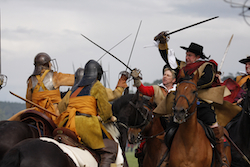|
.jpg) .jpg)
.jpg) 
The English Civil War (1642-1651) was a series of armed conflicts and political
machinations between Parliamentarians and Royalists. The first (1642–1646) and
second (1648–1649) civil wars pitted the supporters of King Charles I against
the supporters of the Long Parliament, while the third war (1649–1651) saw
fighting between supporters of King Charles II and supporters of the Rump
Parliament. The Civil War ended with the Parliamentary victory at the Battle of
Worcester on 3 September 1651.
The Civil War led to the trial and execution of Charles I, the exile of his son,
Charles II, and replacement of English monarchy with first, the Commonwealth of
England (1649–1653), and then with a Protectorate (1653–1659), under Oliver
Cromwell's personal rule. The monopoly of the Church of England on Christian
worship in England ended with the victors consolidating the established
Protestant Ascendancy in Ireland. Constitutionally, the wars established the
precedent that a British monarch can not govern without Parliament's consent,
although this concept was established only with the Glorious Revolution later in
the century.
.jpg) .jpg)
.jpg) .jpg)
.jpg) .jpg)
.jpg) .jpg)
.jpg) .jpg)
.jpg) .jpg)
.jpg) .jpg)
.jpg) .jpg)
.jpg) .jpg)
.jpg) .jpg)
.jpg) .jpg)
.jpg) .jpg)
.jpg) .jpg)
.jpg) .jpg)
.jpg) .jpg)
.jpg) .jpg)
.jpg) .jpg)
.jpg) .jpg)
.jpg) .jpg)
.jpg) .jpg)
.jpg) .jpg)
.jpg) .jpg)
.jpg) .jpg)
.jpg) .jpg)
.jpg) .jpg)
.jpg) .jpg)
.jpg) .jpg)
.jpg) .jpg)
.jpg) .jpg)
.jpg) .jpg)
.jpg) .jpg)
.jpg) .jpg)
The wars left England, Scotland, and Ireland among the few countries in Europe
without a monarch. In the wake of victory, many of the ideals (and many of the
idealists) became sidelined. The republican government of the Commonwealth of
England ruled England (and later all of Scotland and Ireland) from 1649 to 1653
and from 1659 to 1660. Between the two periods, and due to in-fighting amongst
various factions in Parliament, Oliver Cromwell ruled over the Protectorate as
Lord Protector (effectively a military dictator) until his death in 1658.
Upon his death, Oliver Cromwell's son Richard became Lord Protector, but the
Army had little confidence in him. After seven months the Army removed Richard,
and in May 1659 it re-installed the Rump. However, since the Rump Parliament
acted as though nothing had changed since 1653 and as though it could treat the
Army as it liked, military force shortly afterwards dissolved this, as well.
After the second dissolution of the Rump, in October 1659, the prospect of a
total descent into anarchy loomed as the Army's pretence of unity finally
dissolved into factions.
Into this atmosphere General George Monck, Governor of Scotland under the
Cromwells, marched south with his army from Scotland. On 4 April 1660, in the
Declaration of Breda, Charles II made known the conditions of his acceptance of
the Crown of England. Monck organised the Convention Parliament, which met for
the first time on 25 April 1660. On 8 May 1660, it declared that King Charles II
had reigned as the lawful monarch since the execution of Charles I in January
1649. Charles returned from exile on 23 May 1660. On 29 May 1660, the populace
in London acclaimed him as king. His coronation took place at Westminster Abbey
on 23 April 1661. These events became known as the English Restoration.
Although the monarchy was restored, it was still only with the consent of
Parliament; therefore, the civil wars effectively set England and Scotland on
course to adopt a parliamentary monarchy form of government. This system would
result in the outcome that the future Kingdom of Great Britain, formed in 1707
under the Acts of Union, would manage to forestall the kind of often-bloody
revolution, typical of European republican movements that followed the Jacobin
revolution in 18th century France and the later success of Napoleon, which
generally resulted in the total abolition of monarchy. Specifically, future
monarchs became wary of pushing Parliament too hard, and Parliament effectively
chose the line of royal succession in 1688 with the Glorious Revolution and in
the 1701 Act of Settlement. After the Restoration, Parliament's factions became
political parties (later becoming the Tories and Whigs) with competing views and
varying abilities to influence the decisions of their monarchs.
.jpg) .jpg) |